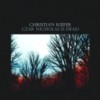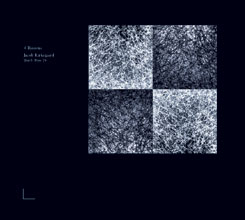- Administrator
- Albums and Singles
 Veteran producer Sherard Ingram, perhaps best (un)known as the mysterious Drexciyan DJ Stingray, drops a full length of delectable abrasive electro that honors the memory of James Stinson while challenging conventions and often experimenting wildly.
Veteran producer Sherard Ingram, perhaps best (un)known as the mysterious Drexciyan DJ Stingray, drops a full length of delectable abrasive electro that honors the memory of James Stinson while challenging conventions and often experimenting wildly.Read More
- Administrator
- Albums and Singles
 Nils Erga is absent and gone with him is his viola. In his place is Anders Hana, member of Ultralyd and Moha!, and some tight underwear presumably hugging a woman's ass. Hana has some big shoes to fill with Erga gone, but manages to make great use of his guitar, summoning electric freak outs to accompany the band's mucky delivery.
Nils Erga is absent and gone with him is his viola. In his place is Anders Hana, member of Ultralyd and Moha!, and some tight underwear presumably hugging a woman's ass. Hana has some big shoes to fill with Erga gone, but manages to make great use of his guitar, summoning electric freak outs to accompany the band's mucky delivery.
Load
The name Anders Hana scares me: I didn't like his solo release on Utech (it bored me to tears) and Moha! isn't a band to write home about. Each release demonstrated Hana's love for the guitar, but didn't showcase a single ounce of song writing talent. Noxagt, on the other hand, are precise and powerful. For all their energy and manic presentation, their music is beautifully arranged and written. It would seem, then, that Hana has found himself a home. Paired with the heart-attack-inducing, rhythmic convulsions of Kjetil D. Brandsdal and Jan Christian Lauritzen, Hana's guitar finally sounds fantastic. His love for the instrument brings the whole album home.
Brandsdal and Lauritzen still like to sound as though they're trying to fight themselves out of a paper sack with a chain-saw, but their sloppy, muggy chops are now highlighted by a guitar. At first the difference isn't readily apparent. Erga's viola work was magnificent, making the instrument sound natural in a setting it wouldn't normally be placed in. Replacing that sound with a guitar has its advantages, though, one of them being Hana's ability to let the instrument lead him as much as he leads it. Feedback, the light hum of strings being teased, and the shriek of an abused fret board figure heavily on this album, making it a rougher and more sizzling album than anything else in the band's discography.
The differences are not enormous, even if they become more obvious later. This album chugs more than their other records, it has more open space rather than more chaotic arrangements. Everything is much slower and more focused on timbre this time around. Noxagt remains the same in the most essential ways, Hana has simply entered to modify their presentation. Noxagt fans might be disappointed by the lack of viola power on this record, but Hana has finally proven he's a competent musician and band member. In the end, this is a tweak in the band's work that I suspect will birth more and different fruit in the future.
samples:
Read More
- Administrator
- Albums and Singles
 Dave Pajo has historically been known as the go-to man for guitar ability and sound: when Billy Corgan told Matt Sweeney "I want to get that guitar sound in Slint," Sweeney's reaction was simply, "Why don't we just get the guitarist from Slint?" On his second release under his last name, Dave has taken things further and demonstrated he has mastered the technique of total songcraft, something deftly exhibited on Pajo but perfected here.
Dave Pajo has historically been known as the go-to man for guitar ability and sound: when Billy Corgan told Matt Sweeney "I want to get that guitar sound in Slint," Sweeney's reaction was simply, "Why don't we just get the guitarist from Slint?" On his second release under his last name, Dave has taken things further and demonstrated he has mastered the technique of total songcraft, something deftly exhibited on Pajo but perfected here.
Drag City
When I first saw his first self-led project live, Aerial M, David wouldn't even face the crowd, nevermind singing in front of a crowd. Over the years his vocals have become more prominent and here it seems like they're no longer just another instrument, but in the driver's seat of the song, taking front row center at times while an arrangement of organ, piano, and strings now accompany competant guitar, bass, and drumming. I have always been impressed with every step Pajo has taken along the way with the evolution of his own projects, but more than ever, he is showing his true talents as a fully-realized multi-faceted composer.
For the most part, David presents an album with a heaping amount of variety. Not only does he show that he can do Beatle-esque blues and power pop with songs like "We Get Along, Mostly" and "Foolish King," but he even makes a kind of nod to the old Aerial M days with the instrumental "Insomnia Song." Most of the first half of 1968 is very dark, subject wise, despite the bright, white cover and lush, elegant booklet. "Who's That Knocking" opens the album with words like a very grim lullaby and musically it shifts between some contrasting movements without a weak spot in its nearly six minutes. "The Devil Wants His Revenge" comes up a couple times, adding more evidence to my theory that Pajo must have signed a pact similar to Robert Johnson's: Dave's just too damned talented.
Even though he has been spending much of his time recently in Brooklyn, he's almost more in touch with his country roots than he has ever been, comically singing about "hillbilly killers on the run" in "Wrong Turn," followed by a murder and cannibalism by a river story in "Cyclone Eye." Additionally, he makes a nod to the Papa M singles series (the One, Two, Three,... EPs where songs were recorded at friends' places), however, where Papa M would include the collaboration of friends, "Walk Through the Dark," is a very introspective song with the recording made alone in a hotel.
The full sound returns for the endearing "Let It Be Me," and if there's a drum machine playing these beats on this or any of the other songs on 1968 (like it sounded like on Pajo), he's done a briulliant job of making them sound real nearly everywhere. "I've Just Restored My Will To Live Again," ironically ends the album on a very lyrically bright and optimistic note, completely contrasting the context of the song, recorded with only a simple guitar and voice on what's probably a very crummy, hand-held recorder.
1968 is very fluid, comfortable, and full sounding, and it's time that David Pajo isn't just "that guy who played with Tortoise, Stereolab, Royal Trux, Zwan, and Slint" (and that alone wouldn't be a bad way to be known) but regarded for his own strengths as an excellent composer and arranger.
samples:
Read More
- Administrator
- Albums and Singles
Read More
- Administrator
- Albums and Singles
 Barbara Morgenstern's whirlwind world tour inspired themes of changes and the nature of time on her first album since 2003's Nichts Muss. Her arrangements are frequently minimalistic, yet she strikes a delicate balance between warmth and precision that indicates a maturation of her pop sensibilities.
Barbara Morgenstern's whirlwind world tour inspired themes of changes and the nature of time on her first album since 2003's Nichts Muss. Her arrangements are frequently minimalistic, yet she strikes a delicate balance between warmth and precision that indicates a maturation of her pop sensibilities.
Exposure to new cultures informs the observation of the title track, an incantation that’s more piano than electro. That balance is rectified with the addictive “The Operator,” one of the album’s singles. Beat-friendly, its chorus is alluringly bittersweet in its reflection of constant motion even as it seems a little out of place among the album’s less frenetic material. The electronics are on equal footing with her piano playing when Morgenstern slows down on “Polar” and “Das Schöne Einheitsbild,” supplementing her melodies with blips and rhythms that prevent the songs from straying completely into unadorned singer-songwriter territory.
Morgenstern does a good job of keeping things fresh with changes in mood and instrumentation. On “Juist,” a slower instrumental, she brings in distorted elements that grab noticeable attention. Likewise, on “Alles Was Lebt Bewegt Sich,” the fuzzed sounds belie the song’s pop sheen and slowly gain prominence. She returns to electronic beats on “Quality Time” and “Mailand” before closing with the melancholic “Initials B.M.” The countries she visited on tour may not reflect so much in the music itself, but appear instead in her lyrics. “Die Japanische Schranke,” for instance, refers to a squeaky railway gate she encountered in Tokyo while “Unser Mann Aus Hollywood” is a story about an unhappy dream. In addition to the songwriting itself, one of Morgenstern’s strengths is her voice, which is pleasant to hear whether singing solo or with her own backing harmonies.
A few of the tracks could stand to be shortened, but that’s only a minor complaint for such an accomplished and satisfying album.
samples:
Read More
- Administrator
- Albums and Singles
 Christian Kiefer’s latest album is a mostly instrumental exploration of the Russian revolution. Among other instruments, he uses guitar, strings, and field recordings to create a stunning work both vivid and haunting in its cinematic evocations.
Christian Kiefer’s latest album is a mostly instrumental exploration of the Russian revolution. Among other instruments, he uses guitar, strings, and field recordings to create a stunning work both vivid and haunting in its cinematic evocations.
Kiefer sets the scene with "Yurovsky’s Lament," a mysterious and melancholic foreshadowing of events to come with its swooping drones and ominous guitar. Chirping crickets crossfade into the next track, one of the many layers of field recordings that lend the music a visual quality. Likewise, the closing latches or doors of "On Suffering Grief," the birdsong, the barking dog, and the mimicked horse trots of "Dubinushka," as well as the radio intercepts of "The Politburo Dreams of the Urals" can’t help but fire my imagination as if I’m listening to a film that’s playing in the next room, yet these subtle elements never overshadow the songs themselves. The music does its part to further the narrative with the snappy percussion of "The Firing Squad" or the peaceful "Koptyaki Road, Night."
It’s not all gloom and sadness here, either. In addition to the calm of "Koptyaki Road," "Kalmykov (Poppies)" unfurls into a stately—if not optimistic—supplication. Even "On Suffering Grief" reflects a carefully ordered worldview of acceptance rather than tragedy or betrayal. The only vocals on the album come on the interpretation of a Russian folk melody, "Troika." On it the harmonizing vocals are accompanied by drums that could signal both a death march and gunshots in the album’s harrowing finale.
Kiefer does a remarkable job of shifting moods and atmosphere to maintain the album’s energy, wrapping me in a dream with several signposts but few absolutes, ensuring a different imaginative landscape with each listen.
samples:
 
Read More
- Administrator
- Albums and Singles
 Another outstanding mini-release from Newcastle’s Jazzfinger collides with another undeniably gorgeous piece of Low Point artwork. Rarely do things that look this good, sound the same. Playing as both their standard duo, and expanded trio team, this two tracker 3" CD-R reveals further facets to their sound.
Another outstanding mini-release from Newcastle’s Jazzfinger collides with another undeniably gorgeous piece of Low Point artwork. Rarely do things that look this good, sound the same. Playing as both their standard duo, and expanded trio team, this two tracker 3" CD-R reveals further facets to their sound.
The duo piece, "The Shadow Between Two Worlds", takes an 11rpm vinyl crackle that trickles through a wall of muggy air. Heavy static drafts attempt to conceal contact mic'd minimalism where there appears to be a great distance moved in-between the song and the aural foreground. Intense burbles of something are halted by mini-sized screeching frequency raids, kicking in doors and knocking down tables. Even as it becomes overtaken by insistent feedback it remains grounded instead of imploding into wankery.
Half as long and more than twice as sharp, "Maypole" has the sound of a more audible interaction process that involves the hands of humans. Playing as a trio, they incorporate floating member Ben Wilkinson and his input into a harsher skewering sound. Offering up an underpinning buzz of what could either be a flypaper buzz or a far-flung off-mic vocal, this is the band at their most spikey and trebly yet.
samples:
 
Read More
- Administrator
- Albums and Singles
 Dedicated to “individuals who burn the flags of nations,” Gjöll’s debut is a concept album in five parts about a character’s anger arising from the state of today’s materialist society, blaming its oppressive politicians and advertisers alike. Dark and brooding, the album is heavy on atmosphere that’s perforated by bleak lyrics.
Dedicated to “individuals who burn the flags of nations,” Gjöll’s debut is a concept album in five parts about a character’s anger arising from the state of today’s materialist society, blaming its oppressive politicians and advertisers alike. Dark and brooding, the album is heavy on atmosphere that’s perforated by bleak lyrics.
“Part I” is a deep drone surrounded by a few rhythmic elements and an occasional high-pitched tone while appropriately despondent lyrics are spoken in the group’s native Icelandic, some of which roughly translate as “Will my voice be worth anything/When there is nowhere an abyss to be seen?” Except for a change at the end, the music is relatively static and made me anxious for something to happen.
Something does happen in “Part II,” which introduces a heavy beat that bounces between channels throughout the track as the character’s anger builds into scratchy vocals delivered like paranoid propaganda. It’s an enjoyable rhythm with unique timbre, although occasional alterations to the beat would have extended its vitality. A swirling maelstrom erupts on “Part III” as the anger transforms into bitter rage. The vocals are buried under harsh distortion, now and then puncturing the dark clouds as the tornado swells and rumbles, culminating in an effectively grueling howl. “Part IV” isn’t as loud, but it’s just as creepy. A low drone swims in the background under cascading high frequencies while the narrator whispers his revelations from an inner spiritual journey in a chilling manner, aided in part by the low volume of his voice and the deliberateness of his enunciation. “Part V” is a somewhat schizophrenic instrumental, running with the storm of “Part III” for over ten minutes before ceding to a magical, starry nightscape that erases much of the negativity that precedes it.
In accordance with the theme, the group includes a lot of rune imagery in the accompanying booklet but insist that it’s only a reminder that creations in the digital age are temporary when compared to those from previous ages, and not as some romantic notion of life in Viking times. Although it gets off to a sluggish start and some songs suffer from a lack of dynamics, this album still has a lot of powerful dark energy worth many repeated listens.
samples:
Read More
- Administrator
- Albums and Singles
 Zach Condon has been hailed as a genius and practically drooled upon since Gulag Orkestar was released. He deserves it in part, any 19 year old musician with this kind of talent deserves to be recognized for his achievements. With A Hawk and a Hacksaw in tow, Condon has written one of the most attractive, if flawed, pop records of 2006.
Zach Condon has been hailed as a genius and practically drooled upon since Gulag Orkestar was released. He deserves it in part, any 19 year old musician with this kind of talent deserves to be recognized for his achievements. With A Hawk and a Hacksaw in tow, Condon has written one of the most attractive, if flawed, pop records of 2006.
Ba Da Bing!
I know this is eastern European music wrapped up inside a western mind, but this is a pop record of the most elegant and subtle kind. It's alluring because its roots are Balkan. It is inviting because Condon, along with Jeremy Barnes and Heather Trost, write and perform beautiful songs filled with romantic and energetic particles. It is somewhat familiar because Condon, at times, wears his Stephin Merritt badge on his sleeve, conjuring up happy sentiments of The Magnetic Fields while crooning in a low, surprisingly full voice. If there is any doubt about any of this, just look at the songs everyone is talking about. "Postcards from Italy" is probably one of the most downloaded songs from the album and I've seen the Fields-ish "Scenic World" mentioned all across the internet. Condon has definitely struck a chord with a lot of people, but this is also clearly the work of a 19 year old male who's as stunned by this world full of music. Just as stunned, I imagine, as many are by his efforts in bringing the world of music to us.
Some songs, such as the impressive and militaristic "Bratislava" seem overdone, made to be foreign by effort instead of by happy chance or familiarity. It's a nice enough song on its own, but when stacked against the stunning "Mount Wroclai (Idle Days)" and Condon's superlative vocal performance on that song it sounds like it belongs in a circus more so than on this album. Also, the songs where Condon attempts to tune down the exotic characteristics of his music ("Scenic World" and "After the Curtain") sound out of place next to the grandeur of the trumpets, marches, and stomps that are the immediate attractions of Gulag Orkestar. Perhaps other bands have succeeded in melding Western pop music with all the heat and passion that's so obvious in the music of gypsies and mysterious cultures, but Condon hasn't quite developed a knack for it, yet.
That will not keep me from wondering at this odd little album, though. The sultry, celebratory tone Gulag Orkestar has on a whole is smile inducing, worthy of dances and cartoonish facial expressions. The music is romantic and sexy and very wondrous in general, like a child seeing the world for the first time and falling in love with all of it.
Indeed, much of the album sparkles with an innocent charm. Condon's lyrical prowess may not be akin to a great poet's, but his passion for the music is undeniable. The way he utilizes his voice is spectacular and worth buying the album for. This isn't a perfect album and it isn't as groundbreaking as some would have you think, but it is a very good album that stands out among so many other evidently excellent releases this year. Condon should be applauded for being so daring and so goddamned talented. Anyone capable of taking ethnic music and handling it so deftly should be recognized simply because most people who try it end up spoiling their music and insulting the ethnic music they were so fond of to begin with.
samples:
Read More
- Administrator
- Albums and Singles
 A man of extremes, Kirkegaard’s last Touch record was noisescapes recorded in the Earth’s crust. Four Rooms is a record of silent feedback, silence played back into more silence, in four rooms in Chernobyl, Ukraine.
A man of extremes, Kirkegaard’s last Touch record was noisescapes recorded in the Earth’s crust. Four Rooms is a record of silent feedback, silence played back into more silence, in four rooms in Chernobyl, Ukraine.
Radiant silence would be a better description, and Kirkegaard uses the city’s past to explode his paradox by choosing rooms of defined public space: church, auditorium, swimming pool, gymnasium. Rooms rarely silent in their previous life and deathly silent today are given second stories, necessarily suggestive of the noise and chaos of their tragedy but themselves eerily hopeful impossibilities.
Kirkegaard's method will immediately recall Lucier’s I Am Sitting In A Room, though now with the sound of empty space replacing the human-voice within-space. Lucier’s fusion of human presence with spatial sound dynamics—a process that subtracts the tonal uncommonalities—contrasts Kirkegaard’s additive method in which recordings of the empty rooms are layered sometimes 10-high upon each other, equaling squirmy, resonant pools of all-over ambient noise-throb. Whereas Lucier’s work ends in a shimmering dissolve, a Zen conclusion (the artist never endorsed) on both the power and ultimate dependence of human consciousness/presence, Four Rooms takes the ghostly memory of presence and exploits it in a meditation on what history leaves behind or what is always there: the before and after.
At face value the four tracks are extremely effective, immersive ambient pieces, at once calming and sleepy and shrill with the buried howl and throb of frequency pile-up. Album art translates the lacey threads and cold currents that wind and curl over the constant, in-the-red groan of a silence room bursting with itself. To call the music desolate or space-like (how could you resist) is accurate, but knowledge of its genesis makes its experience a confined, earthen thing, creepy given the spaces, but comforting and womblike almost by fact of its existence. On his website, Kirkegaard has incredible pictures of the specific rooms, from the “Zone of Alienation,” looking completely alien, untouched for 20 years, holding back some awesome silence.
samples:
Read More
- Scott Mckeating
- Albums and Singles
This brief split cassette release should’ve yet been another step on Robedoor’s ascent to greatness. And it might’ve been too if it hadn’t been for the pesky well-built post-rock sludge of the flipside.
Robedoor push forward the scrappy “Draining Day” offering with a slow siren of human wheeze hum, normally in their hands this sort of sound would end expanding to swallow acres of brain space. Over the first couple of minutes it kind of finds a niche, but as it lengthens out it just stops delivering; it swamps itself far too early in the race. Robedoor’s attempt at corrugating this rush with the sounds of heavy objects ripping through the air doesn’t help matters. It ends up sounding like a miss-matched mess. The blasts of fog that were designed to force incoming passenger ships into the rocks, sound more like tea lights being blown out. The cassette ends up being a harsh match for Robedoor, Goliath Bird Eater just keeps hitting home.
Beginning with audio from a tank’s vertical lift off the track is soon pinned to the floor with a huge distorto bass line. The slight handed chime of guitar builds slowly in volume, eventually coming to rest on a gorgeous Mogwai lull. The riding out of this almost lo-fi serenity would be enough, but it’s soon pulverized by a huge gut contraction style riff. The bass kicks in and the pace alongside the menace increases, sending the song lurching to an energetic end.
Read More

